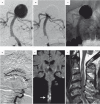Spinal cord infarction is an unusual complication of intracranial neuroendovascular intervention
- PMID: 24355157
- PMCID: PMC3902752
- DOI: 10.1177/159101991301900416
Spinal cord infarction is an unusual complication of intracranial neuroendovascular intervention
Abstract
Spinal cord infarction is an unusual complication of intracranial neuroendovascular intervention. The authors report on two cases involving spinal cord infarction after endovascular coil embolization for large basilar-tip aneurysms. Each aneurysm was sufficiently embolized by the stent/balloon combination-assisted technique or double catheter technique. However, postoperatively, patients presented neurological symptoms without cranial nerve manifestation. MRI revealed multiple infarctions at the cervical spinal cord. In both cases, larger-sized guiding catheters were used for an adjunctive technique. Therefore, guiding catheters had been wedged in the vertebral artery (VA). The wedge of the VA and flow restriction may have caused thromboemboli and/or hemodynamic insufficiency of the spinal branches from the VA (radiculomedullary artery), resulting in spinal cord infarction. Spinal cord infarction should be taken into consideration as a complication of endovascular intervention for lesions of the posterior circulation.
Keywords: complication; intracranial aneurysm; neuroendovascular intervention; spinal cord infarction.
Figures


References
-
- Cheshire WP, Santos CC, Massey EW, et al. Spinal cord infarction: etiology and outcome. Neurology. 1996;47(2):321–330. - PubMed
-
- Kumral E, Polat F, Güllüoglu H, et al. Spinal ischaemic stroke: clinical and radiological findings and short-term outcome. Eur J Neurol. 2011;18(2):232–239. - PubMed
-
- Satran R. Spinal cord infarction. Stroke. 1988;19(4):529–532. - PubMed
-
- Estrera AL, Miller CC, 3rd, Huynh TT, et al. Neurologic outcome after thoracic and thoracoabdominal aortic aneurysm repair. Ann Thorac Surg. 2001;72(4):1225–1230. - PubMed
Publication types
MeSH terms
LinkOut - more resources
Full Text Sources
Other Literature Sources

